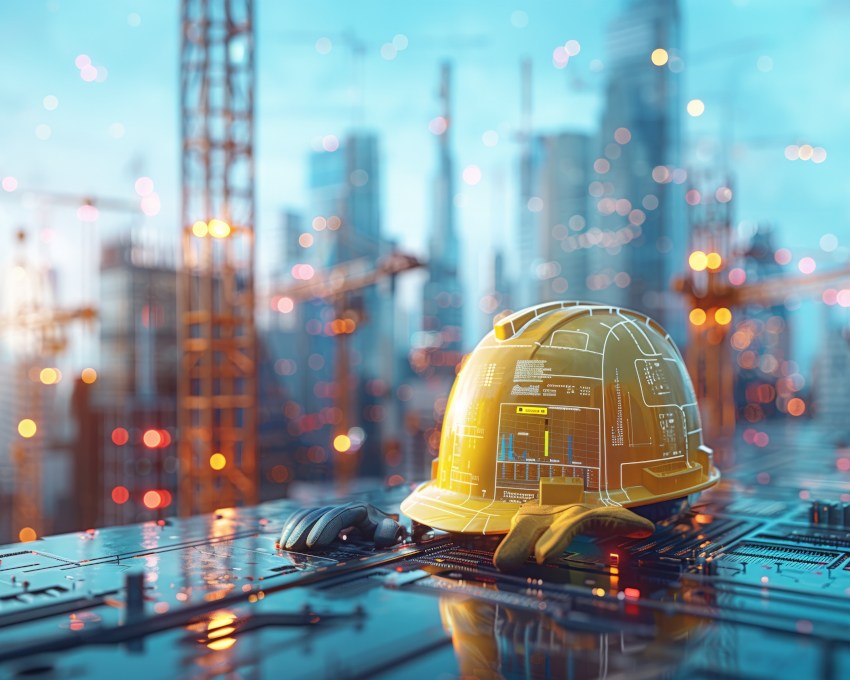
Should smaller firms use artificial intelligence for construction tasks such as document review or renderings from generative image services like Stable Diffusion? AI rendering courtesy of Adobe Stock via Grassi
Data shows that AI continues to grow in usage amongst construction firms — a surprise given the construction industry’s historically slow response to adopting new technologies. Amidst the pressure to adopt, smaller players don’t need to panic: AI adoption isn’t nearly as complicated as it may seem.
AI is the hot topic currently, forcing every industry to reevaluate its own approach toward technology. AI, we’re told, is transformative and powerful, capable of both threatening jobs and building new futures; the key, however, is figuring out how to unlock its ability.
From the outside, the answer of how to use AI in construction would seem obvious: AI could design a project or aid in modeling and projections. In an exacting field like construction, though, there is little margin for error. A single miscalculation or misstep could undo an entire build. So, for a technology that’s still not fully understood or vetted, it can be challenging for construction firms to relinquish control. AI is still hallucinating answers; it remains a black box even amongst those who are developing it.
The average construction firm isn’t going to feel comfortable turning responsibility over to AI — especially not when margins are already so slim. The construction market is still in a state of compression. Profit margins are minimal right now, making every half a percentage point that a company can lower its bid all the more critical for winning projects.
The overhead needed to bring on a new technology for many firms simply doesn’t exist right now, much less for one that’s as complex and unproven as AI.
The lack of capital and concerns about AI’s safety are all preventative layers sitting atop the entry point for most construction firms, creating nervousness and anxiety for leadership at many of the smaller players. How are they supposed to compete for projects, now or in the future, when multi-billion dollar companies are dedicating resources to figuring out how to optimize AI in their work processes?
It’s become something of a modern adage: your job isn’t going to be taken by AI, but it will be taken by someone using AI. For AEC firms, you are not going to lose the next bid to AI but perhaps you will to a firm using AI.
Smaller firms can’t compete in the new technology sphere — but that’s not a dynamic that those in the construction industry are unfamiliar with. Unlike many white-collar industries — where more nimble and less risk-averse startups can often gain the upper hand on large companies by adopting new technologies — the construction industry often allows larger firms to be the first adopters. The transition from CAD to BIM, for example, has been a slow progress, but it has been led by larger companies who have the time, skills, and margins to adopt.
Their decisions trickle down through the industry, creating more clear pathways for smaller firms to understand the how and why behind new systems. AI will likely be much the same; the global and national firms can test new uses and systems while the smaller regional and local firms sit back, waiting for signals that it’s safe before proceeding. That doesn’t mean the smaller players should make no moves. Unlike other construction-specific technologies, AI is shifting how people work and interact in a modern workplace. Instead of treating AI like the next BIM or ERP, construction companies should approach AI like the next smartphone or messaging system — technologies that improve work efficiency without dramatically changing the jobs of what’s done.
Straightforward uses of AI that can be performed on basic generative AI platforms — the ChatGPTs and CoPilots of the world, for example — should be adopted into the AEC workforce. These systems can do things like read and digest contract language, allowing team members to understand more fully what they’re signing up for and what deadlines they’re agreeing to.
It’s a low-risk and low-skill use of AI that can reduce the amount of time that’s being spent on repetitive and redundant tasks that contractors often get weighed down in. It also provides a level of modernization to a workforce that can help to ensure that a firm remains attractive for young hires.
These are not complex uses of AI, but they can build a level of familiarity with the technology that allows bigger and more complex uses to be adopted more seamlessly. It’s like understanding the logic and structure of most phone apps; if you’ve never used one before, adopting one is much more difficult. But if you’ve used one app — even if it’s just for a basic purpose — using the next app is that much more simple.
Because AI will continue to grow and adapt for the construction firm, what may just be a basic review of contracts today may be a first review of design schematics tomorrow. An email draft may soon become a scheduling system, and soon, companies may be able to save an enormous amount of time and money on backend and administrative tasks.
Regardless of size, construction firms should be moving towards AI as a tool that can improve processes already happening in their firm. AI adoption doesn’t need to bring hefty new costs or new talent onto a team; instead, smaller-scale, lower-risk use of AI can provide the training ground that will ensure success in the future. Companies may not fall behind today, but using AI will give firms a leg-up tomorrow.
Carl Oliveri is the Construction Practice Leader and a Partner at Grassi and advises construction owners on financial modeling & strategy.











